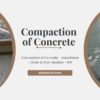Are you annoyed of low-slump and super-hard concrete that is stiff and refuses to flow in forms? If Yes, you need superplasticizers.
What are superplasticizers?
Superplasticizers are admixtures that increase the workability and flow ability of concrete without the need to add excess water. These additives act like high range water reducers and allow designers to make high-strength concrete.
To your surprise, they’re able to transform low-sump and stiff concrete into flowing and pourable concrete with 15% less-water. Now let’s try to understand the role of water in concrete.

The role of water in concrete
Water is added in concrete not only to initiate the chemical reaction, that we call hydration reaction, but is also needed to make concrete workable. Civil Engineers use concrete to make structures in different shapes. We prepare formworks for circular pipes to projected piers and transoms. So; in order for the concrete to flow in congested reinforcement and deep along corners of forms; we need workability in a specific range. However, that doesn’t mean you can add as much water in concrete as you like.
Also read: Modulus of Elasticity of Concrete
Adding excess water not only reduces the strength of concrete but also increases the chance of bleeding and excessive drying shrinkage. Such a concrete would not be durable. You’ll have to repair such concrete frequently in residential and nonresidential sectors.
That’s where water-reducers come handy. Water reduces decreases the amount of water needed in the mix and at the same time improves the workability of wet concrete. Among many other water reducers, superplasticizers are fastest growing.
Also read: Weight of concrete – Density Concrete Slab Driveways
Superplasticizers reduces shrinkage and increases strength
Civil Engineers while preparing mix-designs need to have concrete for special scenarios. Sometimes, they need high-flow concrete but at the same time need high-strength that’s a perfect combo when superlasticizers are used. Similarly, for self-leveling concrete you can achieve a mix without increasing water.
So, if you’re still wondering if superplasticizers (SPs) are problem-solvers, here’re benefits of using superplasticizers in concrete:
-
Reduce shrinkage
One of the biggest concerns in mass concrete is volumetric instability in concrete mass. The water in concrete after hydration leaves the concrete resulting in drying shrinkage. For normal concrete pours, we apply water or moisture during the curing process to withstand tensile forces as otherwise the concrete cracks. Superplasticizers in such cases act as a shrinkage-reducing additives and improves overall durability of concrete.
Also Read: Workability of Concrete – Definition – Factors affecting
-
Reduce thermal cracking
With superplasticizers you can achieve greater volume stability in concrete mix and thus there will be reduced shrinkage or thermal cracking. In case of reinforced concrete; there’re less thermal stresses and therefore thermal reinforcement is not a big need.
-
Increase strength
Superplasticizers have been known to promote the hydration reaction of cement. It results in high early strength. You can achieve concrete with high compressive strength upto 22,000 psi with superplasticizers.
-
Conserve cement
For mass concrete mix designs, we increase water-cement ratio to cater for shrinkage forces but in doing so the strength of concrete is reduced. With such, the only way to improve strength is by increasing cement content in the mix design. With superplasticizers you won’t have to increase the cement content and that’s how it conserve cement which is the most costly constituent in concrete mix.
Superplasticizer and Setting time
In most of the cases, superplasticizers have no impact on the setting time of the concrete mix. Even if there’s some impact, the maximum retard time is about 15 minutes in the initial setting time. However, lignosulfonate-based superplasticizers have been reported to retard the setting time by an hour.
Also Read: What is slump of Concrete? Types -Factors effecting Slump
Disadvantages
Here’re some disadvantages of using superplasticizers in concrete
- It creates problem while finishing concrete. Due to large volume of flowing mix, they tend to be sticky. The concrete pour just pulls and drags the trowel. As a result, the surface deteriorates and tends to move under finisher’s weight. However, you can use coarser fine aggregate and delay finishing to avoid such an annoyance.
- In concrete with superplasticizers, the slump loss is far greater than conventional concrete.
- The concrete are costlier as the additional cost of admixture is there. Superplasticizers are advanced and higher-value chemicals than other water reducers.
- They also increase air entrainment in concrete which is not beneficial in certain structures.
Also Read: Compaction factor test for workability of concrete
Function of Superplasticizers
The main purpose of using superlasticizers is to use flowing concrete along inaccessible locations, floors, or congested reinforcement. It is a water reducing agent that that improves the durability and workability of concrete. With such, designers can prepare high-strength concrete without the need of excessive cement content.
Types of Superplasticizers
There’re many additives and polymers that are commonly used as the base chemical for superplasticizers. Some are classified as below:
- Sulphonated melamine-formaldehyde condensates(SMF)
- Sulphonated naphthalene-formaldehyde condensates
- Modified lignosulphonates(MLS)
- Sulphonic-acid esters
In addition to the above, the following are some new generation high range water reducers which are recently used:
- Acrylic polymer based (AP)
- Copolymer of carboxylic acrylic acid with acrylic ester (CAE)
- Cross-linked acrylic polymer (CLAP)
- Polycarboxylate ester (PC)
- Multicarboxylatehers (MCE)
- Combination of above.



















